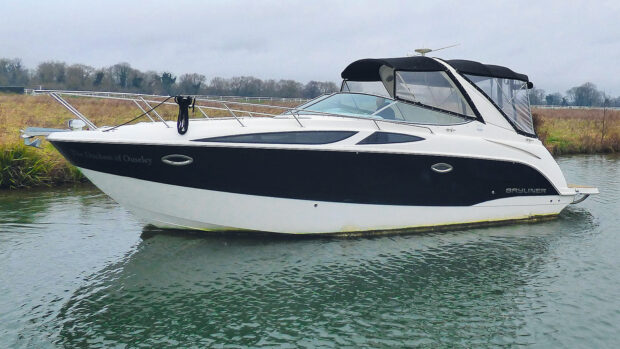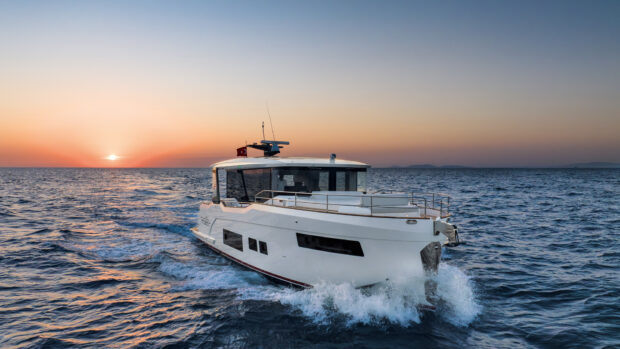Timeless elegance, or a retro classic – the Palm Beach 70 looks dazzling, but there’s lots more to like about this hi-tech and supremely capable yacht
Nearly 30 years ago Mark Richards, Australian yachtsman and boatbuilder, set up Palm Beach Yachts. He named the company after a favourite spot just to the north of Sydney, where he grew up and learned to sail.
A lot of water has flowed under the bridge since then, and to cut a long story short, when the parent company of Grand Banks acquired Palm Beach in 2014, Mark found himself CEO not just of his original company but of Grand Banks as well.
All the boats are now built in the same factory in Malaysia, and share the same revolutionary hull design principles – which in fact originated with Palm Beach – and have a similar onboard aesthetic, with lots of beautiful hardwood joinery, plain off-white panelling and upholstery, and a terrific sense of space. So what’s the difference between a Palm Beach and a Grand Banks?
“Palm Beach is down-east,” Mark concedes with a smile. “But it’s sexier than Grand Banks.” So just as you won’t see a bulky-looking enclosed flybridge on a Palm Beach, or indeed any flybridge at all on many of them, you won’t find an open-top Grand Banks like one of Palm Beach’s GT models.

The long flybridge overhang creates effective cover for the cockpit
Take time out to appreciate the Palm Beach 70’s sleek exterior lines and you’ll quickly see what he means: low-profile and curvaceous in a beautifully understated way, this is a yacht that puts the class into classic with sleek styling that belies its length and height. But it’s also remarkably voluminous, with a beam of over 19ft (5.80m).
So for all its svelte looks, your first impression when you step aboard will be of the sheer size of the thing, from a broad cockpit with its bar and discrete seating areas, to the straightforward symmetry of its main deck layout, where sofas each side, and the separate two-seat helm and navigator’s stations, are divided by a wide walkway up the middle.
But there is also that useful handrail along the saloon deckhead which is such a signature feature of Grand Banks, fitted perhaps as a reminder that although sexier than its sister marque, a Palm Beach yacht is still designed to go to sea.
Big saloon windows emphasise the qualities of an already bright and airy main deck. One reason the cockpit feels so big is that the curved companionway leading up to the flybridge is just inside the door of the saloon, but it barely seems to intrude. Visibility from the lower helm station is also unusually good.

Comfortable fixed sofas in the midships section of the flybridge
Custom build
There are numerous layout options, according to Mark, and the shipyard is willing to talk about owners’ particular requirements. You can have the galley up on the main deck – it would be on the port side forward, so you would lose those nice navigators’ seats – but the Palm Beach 70 at the Cannes boat show last September had the lower-galley option, also on the port side, at the bottom of the companionway.
It’s big and practical, with good worktop and stowage space, and three large cooler drawers instead of a monolithic fridge taking up space in the corner. There is also a slightly unexpected low-level freezer in the aft cabin.

Tall guardrails and head-height handrails make for secure side decks
Extra stowage can be found under the sole in both the galley and in the adjacent lobby area, along with tank and equipment access. Lifting these hatches gave us a chance to admire the concealed fit-out, which appeared to be of a very high order indeed.
In all the more obvious places the finish looked positively perfect. It is perhaps Mark’s ocean racing background, where the slightest flaw or shortcut in build or fit-out might have serious consequences, that underwrites this quality.
The Palm Beach 70’s build is quite hi-tech: the hull is vacuum-infused E-glass, with foam cores, carbon reinforcement and vinylester resin, while the entirety of the deck and superstructure is constructed of vacuum-infused carbon fibre. It’s not just about weight-saving, but where the weight is saved, to keep the centre of gravity as low as possible.
The master cabin up in the bow is pleasantly spacious with an enormous hanging locker, an excellent head compartment and a comfortable-looking armchair. The guest double cabin on the starboard side sports an unusual pair of doors, one hinged and one part sliding, and can boast outstanding headroom at 6ft 9in – about three inches more than the master’s. The master’s bed, on the other hand, is three inches longer than the guest double’s, at 6ft 5in.

Uncluttered, seamanlike foredeck
It is in the aft cabin where the compromises caused by the lower-deck galley come home to roost. It does work, but will take a bit of getting used to with its two different floor levels and three different deckhead heights, where headroom ranges from 5ft 1in at the door to 6ft 2in between the berths.
It is also a bit light on stowage space, with nowhere to hang anything. But it does have that freezer. In the lobby area outside, between the galley and the cabin’s sliding door, there is the small day head and a useful alcove for a washer and drier.
Twenty-four 70s have been ordered so far. Our particular yacht, the eighth 70 since the model’s introduction three years ago, was the first to sport the extended flybridge, which not only provides excellent shelter for the cockpit but also adds significantly to the acreage up top. The extra area could be furnished with free-standing furniture to supplement the dinette fitted amidships, or it could simply be left as it was on our example, as a place to wander about and enjoy the view.
Space is such a luxury on a boat that sometimes it’s best to just leave it alone. For sunbathers there is some padding on the coachroof forward of the windscreen, while down on the bow there is the option of a moulded bow rider seating area, which would be a fun place to be whether at anchor or underway.

Comfortable and well-furnished cockpit.
Down at the other end, our test boat was fitted with the optional Opacmare Transformer hydraulic swim platform. This being a Palm Beach motor yacht, the 70 is also available as a no-flybridge ‘Sedan’ version which not only looks the business, but with its reduced windage and lower centre of gravity would probably be first choice for the purist cruising yachtsman. For the rest of us, however, it might be a bit of a wrench to forgo such an excellent flybridge.
There is just the one engine option with the PB70, but two drive systems: 1,000hp Volvo D13s, either on straight shafts or with the IPS drives fitted to our test boat. The tidy and well-organised engineroom is reached via a hatch in the cockpit sole, with fairly tight access but decent crawling room all round the engines and the two generators mounted in their separate pods between them.

Despite the stairs, the saloon is bright, spacious and well off for seating, with great views
Warp factor
But about that hull design. Mark calls it V-Warp. As a racing yachtsman of considerable repute he has more experience than most of horrible stretches of water like the Bass Strait, so seakeeping is absolutely non-negotiable.
We first got a feel for the design a few years ago in a sea trial of a Palm Beach GT50, but it wasn’t until the 2022 Cannes show, when we took out a Grand Banks 85 in some quite unpleasant conditions (for Cannes), that we could really appreciate just how good it is.

The spacious and elegantly furnished master cabin is located in the bows
The idea is simple: it’s a hybrid, a combination of motor yacht and sailboat principles that joins hard chines and V-bottom forward sections to an upswept stern that ensures minimal immersion, and therefore minimal drag, at the transom. There is a short, shallow skeg along the centreline for directional stability. It works. The GB85 gave us an effortless and pretty dry ride upwind at 18 knots through waves of one to two metres. It also tracked beautifully downwind, something the old GB hulls weren’t always very good at. We were seriously impressed.
This naval architecture is not just about seakeeping, but efficiency too. For our sea trial of the Palm Beach 70 at the 2023 Cannes show, normal service had been resumed: the sea was calm, with just a slight chop, and the wind was light.
All that expensive carbon in the 70’s complicated construction was obvious as soon as we pushed the throttles home and the yacht surged forward way more enthusiastically than its size might lead you to expect. It wasn’t just about weight, or the lack of it. Eager to accelerate as it was, the boat was just as unwilling to slow down. This manifest lack of drag imparted a genuine sense of efficiency and gave us real-time insight into how such an easily driven hull form can return such excellent range figures.

The VIP suite is amidships, opposite the galley
It wasn’t even on its best behaviour, as Mark ruefully acknowledged. The boat had just finished a Mediterranean cruising season, and the hull could have done with a pressure-wash at the very least. But although we got nowhere near the shipyard’s claimed top speed of 34 knots for this boat-engine-drive configuration, we were still burning just 230 litres an hour at 23 knots. Even allowing for MBY’s cautious 20% fuel reserve, that represents a fast cruising range of close on 500 miles, and more with a cleaner bottom.
Of course a generous fuel capacity helps too. Range has always been important to Mark. I wondered if it was an Australian thing – that maybe the distances between decent restaurants are much greater than up north. “No, it’s not that,” he said.
“I’m in the Mediterranean most summers, and in August you can see three-hour queues at the fuel berths. It’s about convenience – it’s so much nicer not to have to refuel all the time.”

Placing the flybridge stairs inside the saloon makes for a very roomy cockpit
Worth the wait
This easily driven yacht was also easy to drive. Handling was excellent, and as positive on the helm as it was on the throttles. We had the Humphree trim system on its automatic setting, on the basis that it would be mad not to make full use of something that works so well, and although this probably moderated the angle of heel we experienced in tight turns, it in no way interfered with our fun.
The Palm Beach 70 has taken a while to get to Europe, but it has been worth the wait. Like one of those über-cool digital cameras that are styled to look like classic Nikons or Leicas, it’s a traditional-looking motor yacht which is secretly rather high tech. It also sports an ultra-modern and seriously impressive hull design. And not only is it put together with all the quality for which Grand Banks was and still is known, it’s officially sexier too.
Palm Beach 70 specifications
LOA: 76ft 3in (23.24m)
BEAM: 19ft 1in (5.83m)
DRAFT: 4ft 4in (1.32m)
DISPLACEMENT: 32.6 tonnes light
FUEL CAPACITY: 6,000 litres
WATER CAPACITY: 935 litres
STANDARD ENGINES: Twin 1,000hp Volvo IPS 1350
OPTIONAL ENGINES: Twin shaft-drive 1,000hp Volvo D13
CONTACT: palmbeachmotoryachts.com
Costs & options
Volvo IPS1350 $84,000
Flybridge $262,500
Humphree stabilisation $96,600
Hardtop $17,900
Seakeeper SK9 $98,200
Transformer aft platform $136,500
Garmin package $44,100











